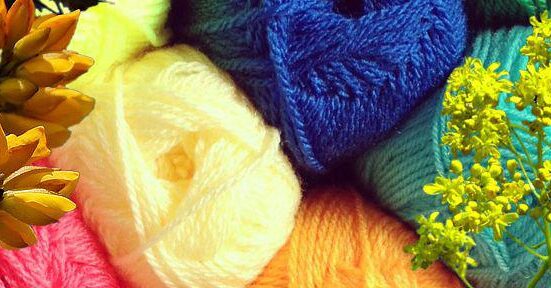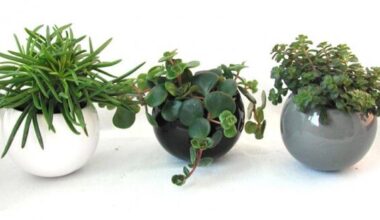Thanks to the pigments contained in their flowers, leaves, roots, berries or bark, some plants can obtain beautiful colors to make their own natural dyes and vegetable paints. These are the dyeing plants, whose botanical name “tinctoria” reveals the nature. We present you 12 plants to obtain natural dyes.
Contents
Yellow and orange dyestuff plants
The yellows are quite easy to obtain and the shades obtained are very numerous, from golden yellows to flamboyant oranges.
1. Isatis tinctoria – Bright Yellow
The most famous of them all, Isatis tinctoria, better known as woad or dyer’s pastel, or Lauragais grass, is a herbaceous plant native to Central and Eastern Asia and Southeastern Europe. The only European plant to naturally provide a blue pigment called Indigo, Isatis has conquered the great courts of Europe.
2. Saffron (Crocus sativus) – Intense yellow to orange
The saffron crocus is a perennial bulb with beautiful purple flowers (Iridaceae family), whose red stigmas are made of saffron and have an astonishing tinting strength: a measure of saffron colors in yellow up to 100,000 times its volume in water. Saffron is also a spice sought after for its incomparable aroma and medicinal properties. This pretty autumn bulb is to be grown in the sun in very well drained soil, even limestone and dry in summer.
3. Dyer’s Chamomile (Anthemis tinctoria) – Yellow, lemon yellow, golden yellow, olive green
Anthemis tinctoria is a herbaceous perennial plant (Asteraceae family), from which the golden yellow pigments are extracted from its dried flowers. The dyer’s chamomile forms beautiful compact, very flowering tufts, composed of small pale yellow daisies with a central golden yellow disc. Like the other varieties of Anthemis, it does not fear rocky, poor and well-drained soils and thrives in full sun.
4. Common Heather (Calluna vulgaris) – Bronze Yellow
All common heathers can produce beautiful pigments with a wide variety of shades. The decoction of the heather gives a very beautiful golden yellow while the young shoots of early spring will give a more olive tone, bronze yellow.
The common heather (Ericaceae family) is adorned with a multitude of small pink bells in August and September to brighten the rocky outcrops, the edges of paths or edges of undergrowth. It also adapts very well to the culture in pots and window boxes, where it will form beautiful seasonal compositions.
5. The Dyer’s Broom (Genista tinctoria) – Yellow
The pigments present in the fresh flowers of the Dyer’s Broom produce different shades of yellow, ranging from bright yellow to golden yellow depending on the variety used. This small shrub forms a beautiful woody tuft that blooms abundantly in May-June.
Sunny and slightly fragrant, the broom is superb in isolation, on the edge or as the first plant of a massif. It appreciates poor, well-drained soils and full sun, but dreads stagnant humidity. Let us not forget that it also has medicinal virtues.
6. St. John’s Wort (Hypericum) – Golden Yellow, Orange and Copper
Tradition has it that the “plant of a thousand holes” is harvested on the evening of St. John’s Day, on the summer solstice. Its flowers then produce a very beautiful golden yellow or, depending on the strength of the baths, copper, red and orange tones.
St. John’s wort (family Hyperaceae) is a hardy perennial plant or shrub that does not fear the cold and is suitable for all soils. It can be cultivated in the garden for its incomparable brightness, or in pots, it will also enjoy it.
Plants of red dyeing
Many plants provide beautiful reds that adorn gardens with their deep, luminous shades. Let yourself also be surprised by the red plant dyes, extracted from green plants … green!
7. The Sulphurous Cosmos (Cosmos sulphureus) – red
Of the daisy family, the cosmos are undoubtedly one of the easiest annuals to succeed. Flowers from the sulphurous cosmos (with orange flowers) are extracted from red dye and paint, while their stems give yellow shades. In tubs, flower beds, borders, the sulfurous cosmos starts to bloom in June and only disappears at the first frost. Their long flowering will attract bees and butterflies to the garden.
8. The Dahlia (Dahlia) – Orange to bright orange red
The dahlia flower (Asteraceae family) provides a beautiful orange more or less sustained depending on the strength of the baths. The shades can also vary from orange to red through pink, depending on the color of the flowers. Just like the sulfurous cosmos or the coreopsis, it is the flower petals that produce the vegetal hues.
Shape, height, color, … there are many varieties of this tuberous plant. One thing is sure, whatever dahlia you choose, its flowering will be renewed all summer long, whether you grow it in the ground or in a tub.
9. The Symphorin (Symphoricarpos albus) – Red Brown
Also known as the “pearl tree”, the snowberry is a very decorative shrub, often planted in hedges. Its summer flowers, discreet pink bells, turn into very graphic white berries until January.
Its tannins are revealed by photo-oxidation (oxidation under the effect of light) and give brown-red tones. Beauty promotes biodiversity in the garden because its flowering is melliferous and its berries attract insects and birds!
Blue and violet dyestuff plants
Periwinkle, céanothe, agapante, plumbago or hydrangea, many blue flowers are present in the garden, but few have dyeing properties. However, there are a few of them among which ..
10. Blackthorn (Prunus spinosa) – Blue
The roots of the blackthorn give a beautiful slate blue. By mixing roots and berries, a colorful blue is obtained. From the ripe sloe berries, picked in October, one can also extract a nice pink, but fragile when washed.
This large shrub or small thorny deciduous tree with a bushy habit is a familiar sight in our landscapes, which it punctuates in spring with a superb white bloom. Well known for its black and edible fruits, the sloes sought after by birds, it has all its place in a country and defensive hedge.
11. The Harvest Blueberry (Centaurea cyanus) – Blue
This blueberry also called Centaurea is a perennial plant which is sown in spring, directly in place, in all types of soil. Alongside poppies and grasses, it gives a slightly old-fashioned charm to naturalistic gardens. The deep and luminous blue of its flowers has long been used for illumination. The cornflower blooms from June to August.
12. Hollyhock (Alcea rosea “nigra”) – Purple, purplish blue
Beautiful shades of purple to purplish blue can be extracted from the petals of the purple hollyhock. This perennial (Malvacea family) or biennial is a must in country gardens where it blooms along the walls, sheltered from the wind. Its floral spikes that can reach more than 2 meters high structure the garden and give it a little Ile de Ré look!
Hollyhocks come in a wide range of colors, from white to purple almost black, through powder pink, creamy yellow, orange and red. Not only dyeing, hollyhocks are also an edible plant: their flower buds and leaves can be eaten raw or cooked, in salads.
Plants with green dyes
The green dye is obtained by mixing blues and yellows. One can also extract pretty green tints from decoctions of fern, elderberry or fig leaves.
How do you get the tinctures from the plants?
The infusion, decoction or maceration can easily obtain a colored bath that will be used to dye your supports. The higher the concentration of plants, the more intense the color. The shades obtained are each time unique!
Whatever the method chosen, your support to be tinted must be prepared in order to fix the color well. This step, called mordanting, can be done with three different mordants: alum, copper sulfate, iron sulfate.
Summary
Here is a selection of 12 colorful plants, common in the garden, and chosen for their ornamental qualities as well as for the richness of their pigments.









